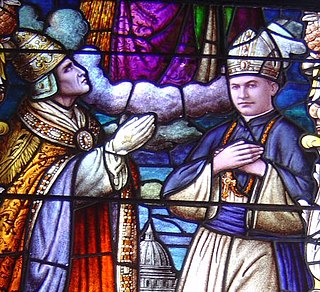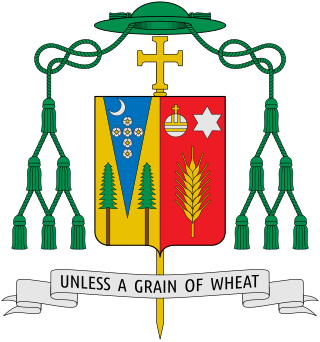The Roman Curia comprises the administrative institutions of the Holy See and the central body through which the affairs of the Roman Catholic Church are conducted. The Roman Curia is the institution which the Roman Pontiff ordinarily makes use of in the exercise of his supreme pastoral office and universal mission in the world. It is at the service of the Pope, successor of Peter, and of the Bishops, successors of the Apostles, according to the modalities that are proper to the nature of each one, fulfilling their function with an evangelical spirit, working for the good and at the service of communion, unity and edification of the Universal Church and attending to the demands of the world in which the Church is called to fulfill its mission.
In Christian denominations, an archbishop is a bishop of higher rank or office. In most cases, such as the Catholic Church, there are many archbishops who either have jurisdiction over an ecclesiastical province in addition to their own archdiocese, or are otherwise granted a titular archbishopric. In others, such as the Lutheran Church of Sweden, the title is only borne by the leader of the denomination.
An ecclesiastical court, also called court Christian or court spiritual, is any of certain courts having jurisdiction mainly in spiritual or religious matters. In the Middle Ages, these courts had much wider powers in many areas of Europe than before the development of nation states. They were experts in interpreting canon law, a basis of which was the Corpus Juris Civilis of Justinian, which is considered the source of the civil law legal tradition.

An exarch was the holder of any of various historical offices, some of them being political or military and others being ecclesiastical.

In Christian churches with episcopal polity, the rank of metropolitan bishop, or simply metropolitan, pertains to the diocesan bishop or archbishop of a metropolis.

In several of the autocephalous Eastern Orthodox churches and Eastern Catholic Churches, the patriarch or head bishop is elected by a group of bishops called the Holy Synod. For instance, the Holy Synod is a ruling body of the Georgian Orthodox Church.
A titular bishop in various churches is a bishop who is not in charge of a diocese. By definition, a bishop is an "overseer" of a community of the faithful, so when a priest is ordained a bishop, the tradition of the Catholic, Eastern Orthodox and Oriental Orthodox churches is that he be ordained for a specific place. There are more bishops than there are functioning dioceses. Therefore, a priest appointed not to head a diocese as its diocesan bishop but to be an auxiliary bishop, a papal diplomat, or an official of the Roman Curia is appointed to a titular see.

An ordinary is an officer of a church or civic authority who by reason of office has ordinary power to execute laws.

A coadjutor bishop is a bishop in the Catholic, Anglican, and (historically) Eastern Orthodox churches whose main role is to assist the diocesan bishop in the administration of the diocese. The coadjutor is a bishop himself, although he is also appointed as vicar general. The coadjutor bishop is, however, given authority beyond that ordinarily given to the vicar general, making him co-head of the diocese in all but ceremonial precedence. In modern times, the coadjutor automatically succeeds the diocesan bishop upon the latter's retirement, removal, or death.
A vicar general is the principal deputy of the bishop of a diocese for the exercise of administrative authority and possesses the title of local ordinary. As vicar of the bishop, the vicar general exercises the bishop's ordinary executive power over the entire diocese and, thus, is the highest official in a diocese or other particular church after the diocesan bishop or his equivalent in canon law.

The hierarchy of the Catholic Church consists of its bishops, priests, and deacons. In the ecclesiological sense of the term, "hierarchy" strictly means the "holy ordering" of the Church, the Body of Christ, so to respect the diversity of gifts and ministries necessary for genuine unity.

Robert Francis Vasa is an American prelate of the Roman Catholic Church. On Monday, January 24, 2011, Vasa was named the coadjutor bishop to Bishop Daniel F. Walsh of the Diocese of Santa Rosa in California by Pope Benedict XVI. Until then, he had been the fifth bishop of the Diocese of Baker in Oregon. On June 30, 2011, Walsh's resignation was accepted by Benedict XVI and Vasa succeeded him as bishop.
A diocesan bishop, within various Christian traditions, is a bishop or archbishop in pastoral charge of a diocese or archdiocese. In relation to other bishops, a diocesan bishop may be a suffragan, a metropolitan or a primate. They may also hold various other positions such as being a cardinal or patriarch.

In the Roman Catholic Church, a judicial vicar or episcopal official is an officer of the diocese who has ordinary power to judge cases in the diocesan ecclesiastical court. Although the diocesan bishop can reserve certain cases to himself, the judicial vicar and the diocesan bishop are a single tribunal, which means that decisions of the judicial vicar cannot be appealed to the diocesan bishop but must instead be appealed to the appellate tribunal. The judicial vicar ought to be someone other than the vicar general, unless the smallness of the diocese or the limited number of cases suggest otherwise. Other judges, who may be priests, deacons, religious brothers or sisters or nuns, or laypersons, and who must have knowledge of canon law and be Catholics in good standing, assist the judicial vicar either by deciding cases on a single judge basis or by forming with him a panel over which he or one of them presides. A judicial vicar may also be assisted by adjutant judicial vicars. The judicial vicar is assisted by at least one, if not more, individuals with the title defender of the bond; they are normally priests, but do not have to be. On staff will also be notaries and secretaries, who may be priests, religious brothers or sisters or nuns, or laypersons.

In the Catholic Church, a bishop is an ordained minister who holds the fullness of the sacrament of holy orders and is responsible for teaching doctrine, governing Catholics in his jurisdiction, sanctifying the world and representing the Church. Catholics trace the origins of the office of bishop to the apostles, who it is believed were endowed with a special charism and office by the Holy Spirit at Pentecost. Catholics believe this special charism and office has been transmitted through an unbroken succession of bishops by the laying on of hands in the sacrament of holy orders.
The Holy Synod of the Coptic Orthodox Church of Alexandria is the highest Orthodox authority in the Coptic Orthodox Church. It formulates the rules and regulations regarding matters of the Church's organisation and faith.

Joseph Anthony Pepe is an American prelate of the Roman Catholic Church. He served as the second bishop of the Diocese of Las Vegas in Nevada from 2001 to 2018.

This is a glossary of terms used within the Catholic Church. Some terms used in everyday English have a different meaning in the context of the Catholic faith, including brother, confession, confirmation, exemption, faithful, father, ordinary, religious, sister, venerable, and vow.

David Dennis Kagan is an American prelate of the Roman Catholic Church. He has been serving as bishop of the Diocese of Bismarck in North Dakota since 2011.

John Francis Doerfler is an American prelate of the Roman Catholic Church who has been serving as bishop of the Diocese of Marquette in Michigan since 2014.










